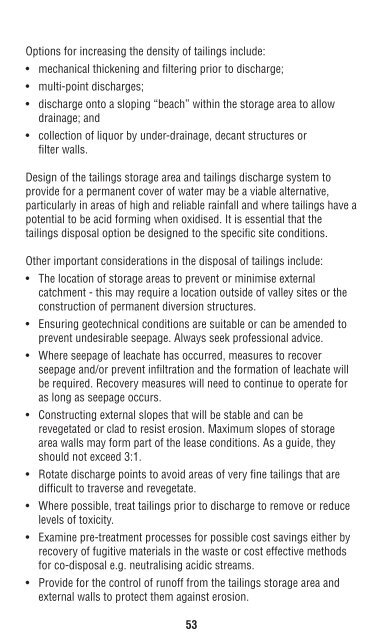Mine Rehabilitation Handbook - Mining and Blasting
Mine Rehabilitation Handbook - Mining and Blasting
Mine Rehabilitation Handbook - Mining and Blasting
Create successful ePaper yourself
Turn your PDF publications into a flip-book with our unique Google optimized e-Paper software.
Options for increasing the density of tailings include:<br />
• mechanical thickening <strong>and</strong> filtering prior to discharge;<br />
• multi-point discharges;<br />
• discharge onto a sloping “beach” within the storage area to allow<br />
drainage; <strong>and</strong><br />
• collection of liquor by under-drainage, decant structures or<br />
filter walls.<br />
Design of the tailings storage area <strong>and</strong> tailings discharge system to<br />
provide for a permanent cover of water may be a viable alternative,<br />
particularly in areas of high <strong>and</strong> reliable rainfall <strong>and</strong> where tailings have a<br />
potential to be acid forming when oxidised. It is essential that the<br />
tailings disposal option be designed to the specific site conditions.<br />
Other important considerations in the disposal of tailings include:<br />
• The location of storage areas to prevent or minimise external<br />
catchment - this may require a location outside of valley sites or the<br />
construction of permanent diversion structures.<br />
• Ensuring geotechnical conditions are suitable or can be amended to<br />
prevent undesirable seepage. Always seek professional advice.<br />
• Where seepage of leachate has occurred, measures to recover<br />
seepage <strong>and</strong>/or prevent infiltration <strong>and</strong> the formation of leachate will<br />
be required. Recovery measures will need to continue to operate for<br />
as long as seepage occurs.<br />
• Constructing external slopes that will be stable <strong>and</strong> can be<br />
revegetated or clad to resist erosion. Maximum slopes of storage<br />
area walls may form part of the lease conditions. As a guide, they<br />
should not exceed 3:1.<br />
• Rotate discharge points to avoid areas of very fine tailings that are<br />
difficult to traverse <strong>and</strong> revegetate.<br />
• Where possible, treat tailings prior to discharge to remove or reduce<br />
levels of toxicity.<br />
• Examine pre-treatment processes for possible cost savings either by<br />
recovery of fugitive materials in the waste or cost effective methods<br />
for co-disposal e.g. neutralising acidic streams.<br />
• Provide for the control of runoff from the tailings storage area <strong>and</strong><br />
external walls to protect them against erosion.<br />
53<br />
6.2.1 Tailings Characterisation<br />
The physical <strong>and</strong> chemical properties of tailings materials will determine<br />
the extent to which vegetation of the tailings is practical <strong>and</strong> what other<br />
options may need to be considered. Characteristics of tailings that<br />
inhibit plant growth include:<br />
• high concentration of heavy metals <strong>and</strong> salts;<br />
• extremes of pH;<br />
• lack of essential plant nutrients;<br />
• lack of microbiological organisms;<br />
• textural <strong>and</strong> structural characteristics which limit aeration <strong>and</strong><br />
infiltration;<br />
• high levels of reflective light or heat absorption in light or dark<br />
tailings causing physiological stress to vegetation; <strong>and</strong><br />
• physical damage by s<strong>and</strong> blast.<br />
The extent to which these problems exist for any single tailings area will<br />
need to be determined. Essential information required includes:<br />
• particle size distribution;<br />
• existing pH <strong>and</strong> likely changes in pH values over time;<br />
• chemical dem<strong>and</strong> (<strong>and</strong> likely cost) to achieve pH neutrality;<br />
• level of heavy metals or other plant toxins;<br />
• changes in toxicity levels likely with pH adjustment;<br />
• in-situ water infiltration characteristics; <strong>and</strong><br />
• changes in physical <strong>and</strong> chemical properties with depth (at least in<br />
likely root zone).<br />
6.2.2 Treatment Options<br />
• Permanent Water Cover<br />
Where tailings have high sulfide levels <strong>and</strong> have potential to be<br />
acid-forming or are slow to settle, the tailings disposal system may be<br />
designed to provide for a permanent water cover. This approach<br />
prevents the oxidation of the tailings <strong>and</strong> eliminates the need for<br />
consolidation. It is essential that the disposal system be designed to<br />
ensure that there is a permanent water cover but, at the same time,<br />
avoiding seepage, overtopping etc. This technique has limited<br />
application in Australia because of the generally high evaporation rates.<br />
54
















